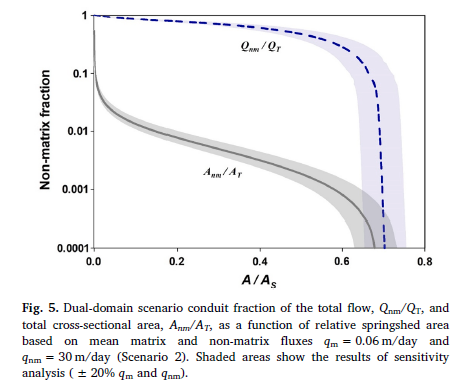Our new paper (link here) in Journal of Hydrology examines the groundwater flowing to Silver Springs, FL, one of the largest freshwater springs in the world. The freshwater springs on north-central Florida are widely recognized as natural wonders. However, water quality in many springs in Florida has degraded over the past 30 years. In order to protect and manage spring water from pollutants, it is essential to understand the pattern of groundwater flow in complex karst aquifers. Groundwater flow discharging to springs from carbonate aquifers is governed by the interaction of slow matrix flow and fast conduit flow, which creates highly complex flow and transport conditions. An important unknown is the relative contribution of matrix and conduit flow to the total discharge. We addressed this question with an experimental investigation of groundwater fluxes in the Floridan aquifer within the springshed of Silver Springs.
We applied simple analytical model techniques coupled with novel in situ measurements of groundwater fluxes. In situ water flux measurements spanned multiple orders of magnitude (Figure 3 from the paper below). The model developed using these data found that non-matrix portions of the aquifer, conduits, contribute the majority of the flow but represent only a very small fraction of the aquifer. For example less than 10 km from the spring outlet (at relative springshed area A/As =0.1), the non-matrix (conduit) zones deliver nearly 90% of the flow through the aquifer but account for only 2% of the aquifer cross-sectional area (Figure 5 from the paper below). At A/As =0.5, the non-matrix area accounts for 0.2% of the total, while approximately 50% of the flow is carried by non-matrix. Thus, field samples at this distance are approximately 500 times more likely to encounter matrix zones than non-matrix. Consequently, as the distance from the spring outlet increases, it would be challenging to directly detect non-matrix flows such as conduits or caves that are observed within the vicinity of the spring outlet. Even near the spring, numerous monitoring wells would be needed.
Our model results showed good agreement with measured groundwater data (Figure 8 from the paper below), especially when compared with a “too simple” model of a homogeneous aquifer that does not account for the conduit pattern shown in Figure 5. The results of this study offer field-measured hydrogeologic data that can be used for active resource management in springsheds, and the simple modeling approach may be applicable to other springsheds to estimate the relative contributions of fast and slow water flow and solute transport pathways to the spring outlet.



